
headdamage
-
Posts
74 -
Joined
-
Last visited
Content Type
Profiles
Forums
Events
Gallery
Blogs
Posts posted by headdamage
-
-
I had not heard of this happening before, thanks for the heads up.
-
I just driven back to Yellowknife, the heater was slightly better on the hwy than on the way down but still not great. Back in Yellowknife the RRC is much warmer around town as the Webasto keeps the engine temp up and it is already warm when I get in if I've started the Webasto with the remote ahead of time.
I like the Webasto coolant heater so much right now I'm considering a Webasto Airtop to heat the inside of the RRC in cold weather for next winter.
-
Yellowknife is in the Northwest Territories of Canada. The Range Rover starts down to a bit below -30c but it is not happy about it. With the help of an electric battery blanket and an electric lower rad hose heater it starts quite well below -30 when plugged in for a few hours. My hope is that the Webasto will enable trouble free starts at any temp we are likely to get but it does go below -40 or even to -50 at times and the Webasto is only rated to -40c so I might push it beyond it's limits.

-
Well after all this work the heater is still not very good. By running on recirculate it is better but the main issue seems to be the fact that the engine is not hot enough. So to help this I've installed a Webasto engine heater.
Some photos of my Webasto heater installation:





-
I think I may have fixed the heater. I've foam tape sealed the core into the housing and adjusted all the air flaps.
I also bent the aluminum section that covers up part of the core to an angle that seems it would allow much better air flow. Forgot to take a photo of this part.
Bench testing the heater with hot tap water and a battery to run the fan resulted in a core temp of approx 55c and a exiting air temp of approx 50c with the water exiting the core at approx 55c. I should have done this bench test before stripping the heater to establish a bench mark but it seems likely that the heater is working well now. Now all I have to do is stuff it all back into the lair of the spaghetti monster :mm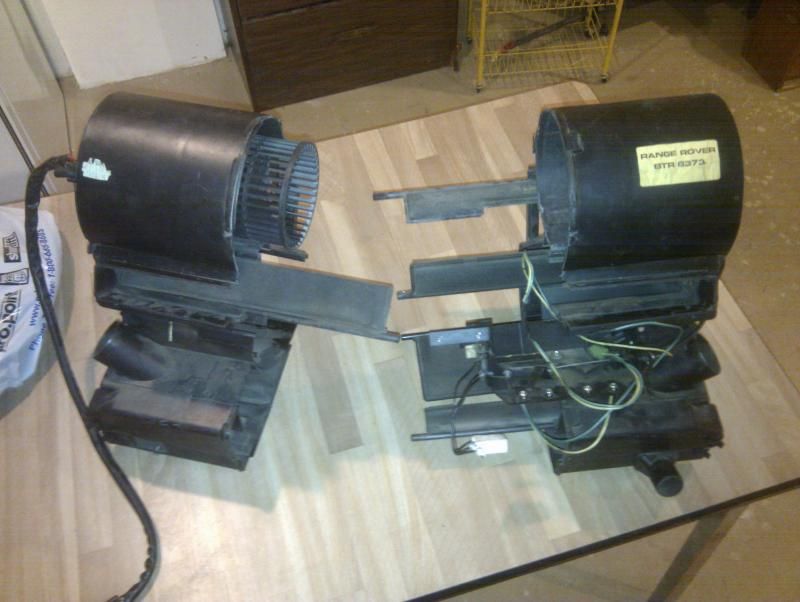
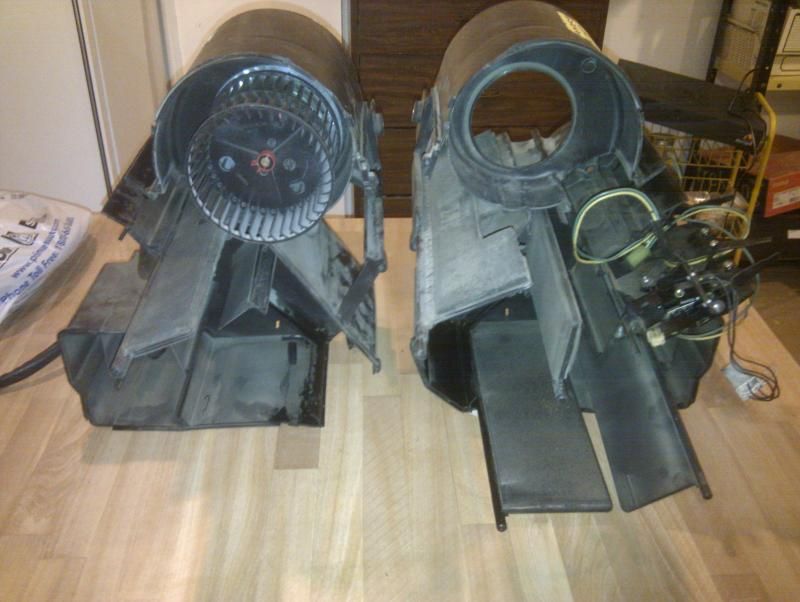
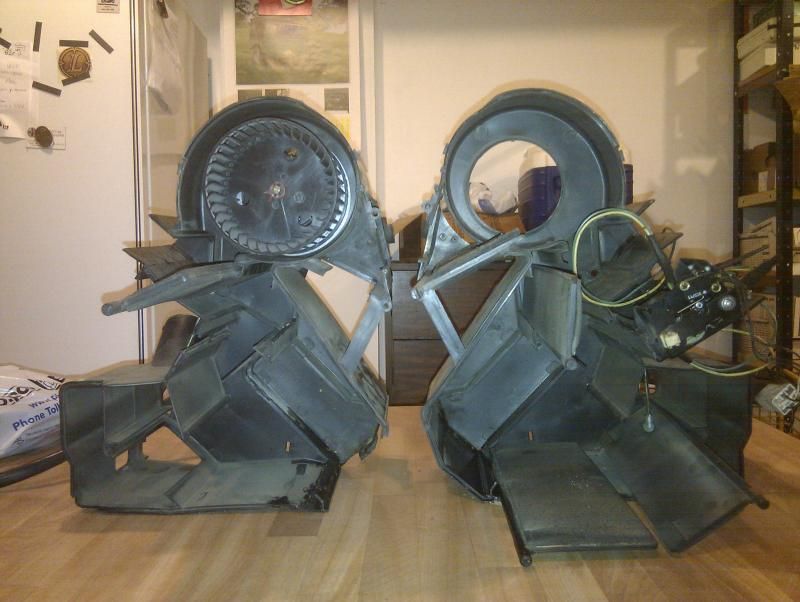
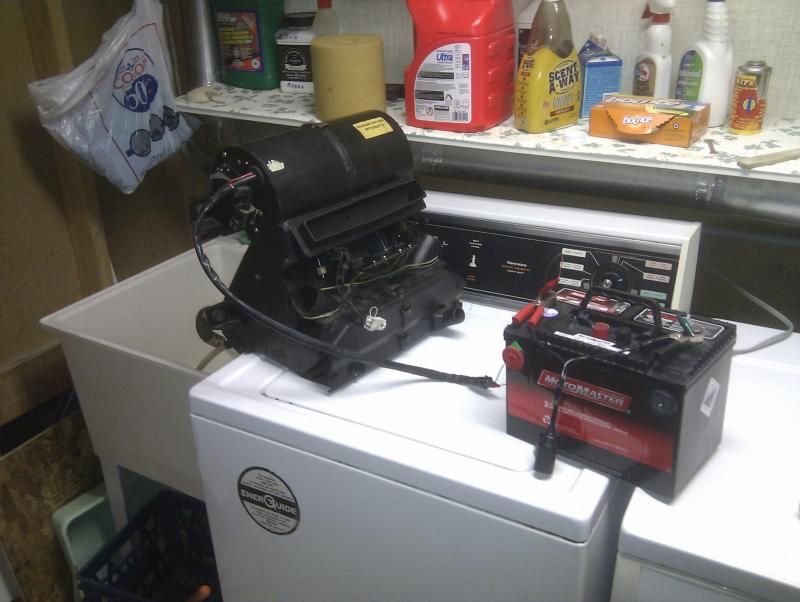
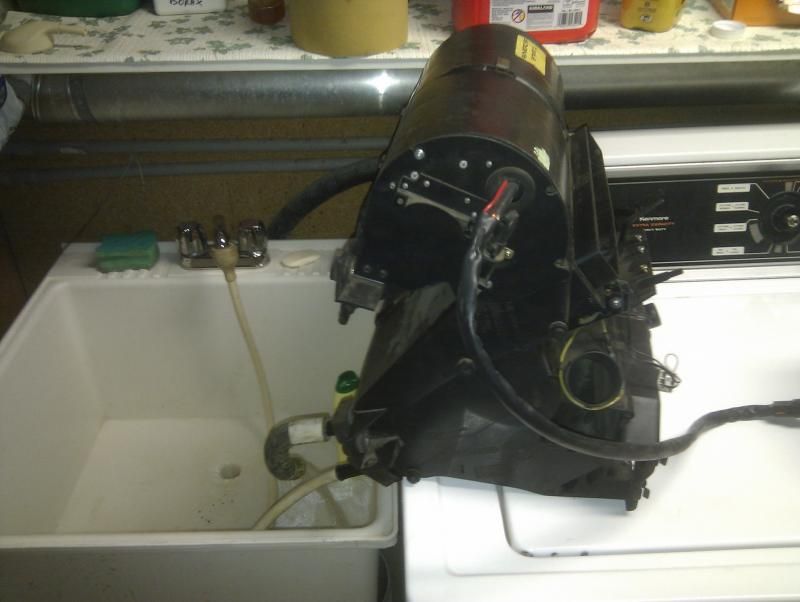


-
I took the fan off for a 1800km trip from Yellowknife to Calgary a couple of weeks ago, it didn't seem to help.
-
The blower works great, moves lots of air. Not a lack of air movement but perhaps a lack of air passing through the core.
Funny thing is the AC works better in this RRC than any vehicle I've driven, I could use it as a meat locker when it is +30 outside.
-
The main radiator is three years old as it the thermostat, both in good shape. IR thermometer measures lower T-stat temp of over 85c before the upper rad hose gets any heat in it so I believe that is working.
My other vehicle is a 1996 Chev 6.5 turbo diesel and it makes lots of heat though at -35c it does have trouble keeping the windows ice free, still comfortable for the passengers just icey windows. The RRC is freazing at those temps.
based on the fact that the water is almost as hot coming out of the core as going in I'm convinced the issue has to do with air flow not all being force through the core and somehow bypassing it.
-
I hate the heater in my 1993 200tdi Range Rover Classic! It has not been working very well for the last couple of years, blows warmish air when it is cold and cool air when it is really cold out.
At -15c on the hwy the water entering the heater core is around 80c to 90c, the water leaving the heater core is around 75c to 85c, the air coming out of the vents is 35c (55c with recirculation on).
When is is -30c to -40c, as it often is in Yellowknife, the air coming out of the vents is about 0c to maybe 10c.
I've managed to get a infrared thermometer into the heater housing and with the engine at 40c and the heater core at 35c the air coming out of it was 10c to 15c with an ambient temp of about 5c. This is pathetic.
I've just torn the whole heater assembly out of the RRC and taken it apart to try and figure out why it works so poorly. I can't find anything wrong with it. The blower is strong, the core is good and flows tap water well in both directions. The blower and core where new about 3 years ago when we did the RHD to LHD conversion.
I tired to test the internal flow of the heater by manually closing flaps in such a manner that it should have blocked air flow from the heater. This did not work and the air flow slowed only a little. I have the feeling that the air has been by passing the core but I can't figure out how.
A couple of other things I did note;
- the water flows from the thermostat housing to the core then back into the rear of the head
- the water flows into the upper core pipe and then out the lower pipe
This is the opposite of how I thought is should flow.
There is also a section of aluminum that is part of the core and blocks about 1/5th of the core, this doesn't seem right.
Any ideas on how to make this RRC warm enough to defrost windows and prevent frost bitten feet in Yellowknife? -
Would theTERRAFIRMA 2 INCH RECEIVER HITCH DISCOVERY 1 (TF874) also fit a Range Rover Classic, in particular a 1993 SWB?
-
Well I got around to doing it and the RRC 200tdi transmission cross member works fine with the LT230

-
The viscous coupling in the Borg in my 1993 200tdi (factory) is seized. I've got a good used LT230 that can go it but I'm not sure what to do about the cross member/mounting system used in this Range Rover. There is a rather funky looking combined cross member and transmission mount and no transfer case mounts. Can I just remove the borg and hang the LT230 on the LT77 or do I have to discard the cross member mounting system and use a standard cross member with separate transfer case mounts like in a 200tdi Defender or a V8 with ZF box? Thanks.
-
I don't know but I'm interested in the answer myself. I've got a 1987 and a 1993 RRC and would like to combine the best bits from both. The wings on the 93 are in great shape but I'd like to use the 87 Doors.
-
The LT77G 51A in my 90 sometimes pops/jumps out of 5th gear on over run. This doesn't happen very often but I'm wondering if I can fix it of if it means something much worse is getting ready to happen? Any advice would be great, thanks!
-
In my case it was fitted in a different location (positive side of the coil) and why will the truck now not run with it in place but runs great without it?
I have to think it has to do with the change from a 2 terminal ignition module to a 3 pin but I'd like to know for sure and should I be using a different resistor or some thing to do what ever this one had been doing?
-
I've had an ignition problem with my 1987 NAS Range Rover Classic. At this point I have replaced the distributor, ignition amp, cap, rotor, wires, condenser, and coil. The truck seems to be running well now but there is one odd thing that is bugging me. When I took it all apart there was a little black thing with male spade connectors on each end of it that was between the positive wire to the ignition coil and the positive terminal on the coil. It says "Lucas RD 953066" on it. It measures about 6.8k ohms resistance. If I put it back in place the truck with not run, no spark. If I leave it out and just hook the positive wire strait to the positive terminal on the coil the truck runs fine.
What the heck is "Lucas RD 953066" for and is there now a problem that I've left it out? I should also add that I had to change from a two terminal ignition amp to a three terminal ignition amp.
Thanks for any help.
-
Turners sells the ERC9188 for the 2.5na, 2.5TD, 200TDI, and 300TDI.
-
Are 12J and 19J cylinder liners the same? I ask because I can find 12J liners but not 19J liners. The block in question dropped a hot spot and damaged one cyclinder bore. It is a late exmil 2.5na, one of the ones that used 19J blocks.
Thanks for any help.
-
How important is it that you follow this caution note in the 200tdi book? \
CAUTION: If the original skew gear and
camshaft are to be re-used, they must be
fitted so that the teeth on each, mesh in the
original position. If either the skew gear or
the camshaft are renewed, the mating
component must also be renewed.
I have, of course, lost track of the relation between the skew gear and camshaft when taking apart my 200tdi for rebuilding.
-
My 90 is an 80's vintage with csw hardtop sunroof, alpine windows, etc... and a safety devices front external middle internal roll cage. Have the le salle sides back and door trim to. Mostly it was a pita because the rover is not quite perfect but the lining is so it just didn't quite want to fit without a lot of trimming and such and I really hate working with grp dust and bits over my head. It is also not very easy to remove and refit when needed as it is so stiff.... seems to make noise worse at some speeds to. Mine has a bad buzz at exactly 80kph somewhere in the back lining but this might not be the le salle's fault. Anyway it looks nice but I just don't like working with it.
-
I've got one in my 90... nice once it is in but it was such a PITA to fit that I don't think I would do it again.
-
What parts are common between the 200tdi RR and the 200tdi Disco, engine, gearbox, rad, inter cooler, etc... ?
Thanks.
-
I friend of mine has bought several rovers from them over the years and he has never had a problem.
-
Does anyone know of an insurance company that will sell short term insurance for a rover to a person with a Canadian drivers licence in the UK?
Thanks.

Military 110 frames?
in Military Forum
Posted
I have an ex REME Rover enthusiast and professional mechanic friend who is certain that 1980's vintage Military 90 and 110 Land Rovers had stronger frames/chassis than the civilian models. Is there any truth to this and if so in what way where they strengthened?